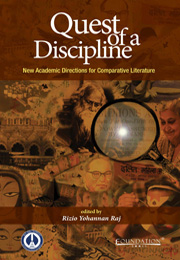Book contents
- Frontmatter
- Contents
- List of Contributors
- Acknowledgements
- Prologue to the “Quest'
- Introduction
- PART I Traditions and Manifestoes: Reflecting on Perspectives
- PART II The Quest Motif: Redefining the Scope of Comparative Literature
- PART III The Dynamics of Exchange: Genres, Areas and Disciplines
- 10 Text and Performance: A Study in Cultural Symbiosis with Special Reference to Kathakali
- 11 The Indian Cartoon Art: A Paradigm for the Emerging Text and Image Experience
- 12 Text and Alter Text: Chinese Literature in Indian Translations
- 13 Arabic Literature in Diaspora: An Example from South Asia
- 14 Literature, Arts and Social Sciences: Interdisciplinary Comparative Advantage
- PART IV India: A Curious Comparative Space
- Afterword: Comparative? Literature?
- Index
12 - Text and Alter Text: Chinese Literature in Indian Translations
from PART III - The Dynamics of Exchange: Genres, Areas and Disciplines
Published online by Cambridge University Press: 05 June 2012
- Frontmatter
- Contents
- List of Contributors
- Acknowledgements
- Prologue to the “Quest'
- Introduction
- PART I Traditions and Manifestoes: Reflecting on Perspectives
- PART II The Quest Motif: Redefining the Scope of Comparative Literature
- PART III The Dynamics of Exchange: Genres, Areas and Disciplines
- 10 Text and Performance: A Study in Cultural Symbiosis with Special Reference to Kathakali
- 11 The Indian Cartoon Art: A Paradigm for the Emerging Text and Image Experience
- 12 Text and Alter Text: Chinese Literature in Indian Translations
- 13 Arabic Literature in Diaspora: An Example from South Asia
- 14 Literature, Arts and Social Sciences: Interdisciplinary Comparative Advantage
- PART IV India: A Curious Comparative Space
- Afterword: Comparative? Literature?
- Index
Summary
INTRODUCTION
Ours is a time full of changes; steady things seem fewer than before. In such a challenging context, most cultures face a common problem: how to value and deal with their own significant past. Literary classics (canons) are both the components and representatives of this ‘important past’, and rethinking them would amount to a conscious reflection on one's tradition. We must remember that one of the reasons a certain literary work is considered a classic is that it often acts as a unified source from where both questions and answers regarding that culture and its values are drawn. It must also be noted that a literature develops and attains a certain status not only by means of its own literary heritage but also through its correlations with foreign literatures. Translations from other languages and cultures bring in new concepts and stimulations to a literature and its culture. Again, translation – if it is interpretation/oral transcreation or written translation – is the inevitable course a literary work has to take in going out into the world, crossing geographical and temporal limits.
Translating the Buddhist scriptures into Chinese had left a lasting impression on the history of Sino-Indian cultural exchanges. Among the translators, including Indian, Chinese and the central Asians, Kāśyapamātanga, Dharmaraksa, Kumārajāva, Zhi Qian, Xuan Zang were the famous ones, and Xuan Zang was definitely the most distinguished figure. With the translation of scriptures, Buddhist literature was introduced into China, and it had a profound influence on Chinese literature.
- Type
- Chapter
- Information
- Quest of a DisciplineNew Academic Directions for Comparative Literature, pp. 182 - 190Publisher: Foundation BooksPrint publication year: 2012



